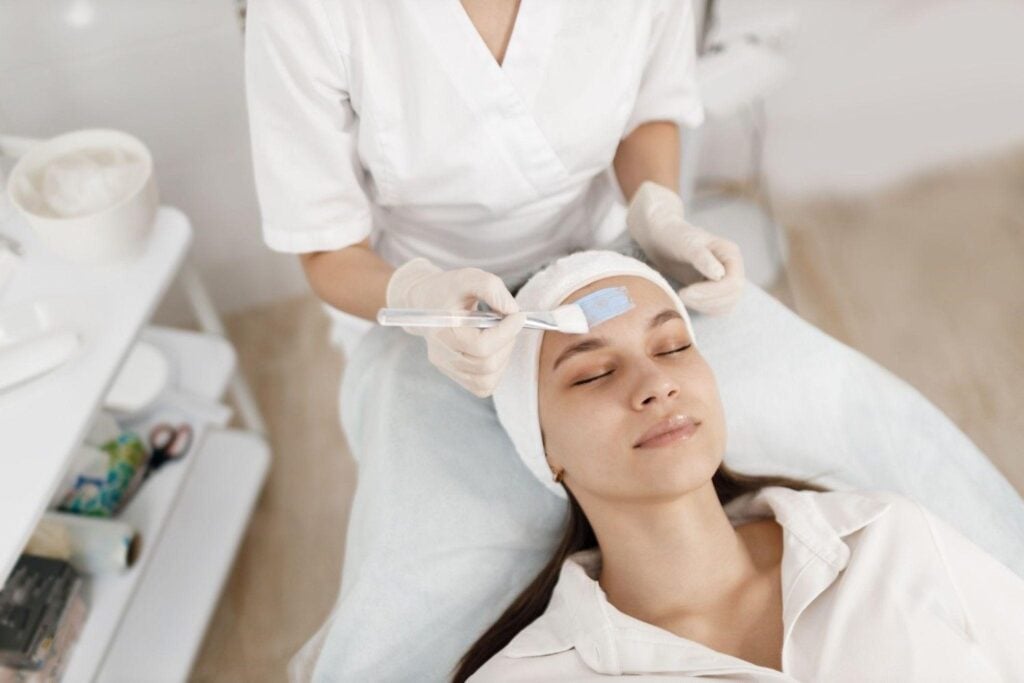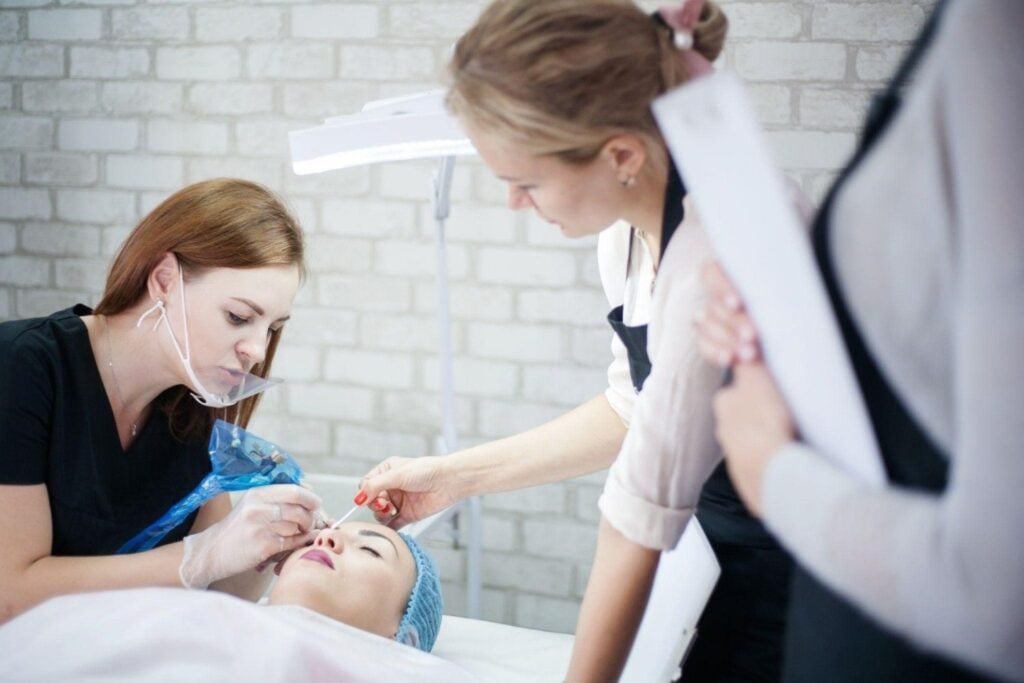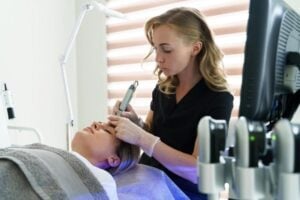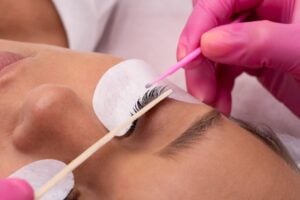Most people when they hear about the difference between “aesthetician” and “esthetician” think it’s just another case of confusing spelling variations. However, these aren’t just different ways to spell the same job, they’re actually two distinct career paths. If you’re thinking about diving into this industry, it’s worth exploring the aesthetician vs esthetician differences before you make any final decisions.

What Sets These Careers Apart
The letter difference actually makes a difference and it tells you about where you’ll end up working.
Estheticians are your classic spa professionals. They’re skincare experts who focus on making you look good and feel relaxed. They’re the ones you’ll find at day spas, high-end salons and wellness retreats, specializing in treatments that are all about beauty enhancement and stress relief.
Aestheticians (also known as a medical or paramedical aesthetician) work in a different world. These professionals operate in clinical settings where everything revolves around medical protocols. They’re working under doctors’ supervision, dealing with serious skin conditions and using medical-grade equipment that requires specialized training.

What Estheticians Actually Do All Day
Traditional estheticians have built their careers around cosmetic treatments. Here’s what fills up their typical workday:
Facial Services
They’ve mastered everything from basic deep-cleaning facials to sophisticated anti-aging treatments.
Each session gets customized based on what the client’s skin actually needs, not just what’s trendy.
Hair Removal Expertise
Professional waxing, threading, and other non-laser methods. It’s more technical than people realize, there’s real skill in doing this safely and effectively.
Skin Assessment
They can look at your skin and actually understand what’s going on beneath the surface. Then they’ll recommend products and treatments that make sense for your specific situation.
The Wellness Factor
Many estheticians incorporate aromatherapy, relaxation techniques, and holistic approaches that address stress as a factor in skin health.
Product Guidance
They help clients navigate the overwhelming world of skincare products, explaining what actually works and how to use it properly.
Most estheticians work in places where the atmosphere is just as important as the treatment. Think luxury spas, resort facilities and wellness centers where relaxation is part of the service.

Medical Aestheticians: A Different Game Entirely
Medical aestheticians tackle more complex skin issues using clinical approaches. Their day-to-day responsibilities look nothing like traditional spa work:
Advanced Scar Treatment
They use medical-grade equipment and techniques to address serious scarring from acne, surgery, or accidents. This isn’t cosmetic improvement. It’s therapeutic intervention.
Laser Tattoo Removal
Operating sophisticated laser equipment requires extensive training in safety protocols and understanding how different skin types respond to treatment.
Post-Surgery Care
When someone has had cosmetic or reconstructive surgery, medical aestheticians provide specialized care to optimize healing and prevent complications.
Medical-Grade Chemical Peels
These aren’t the mild peels you get at a spa. Medical aestheticians perform chemical treatments that can address serious skin conditions but require medical supervision.
Laser Therapy Assistance
They work with dermatologists and plastic surgeons on laser treatments for skin resurfacing, hair removal, and treating vascular issues.
Clinical Skin Conditions
They treat patients dealing with diagnosed medical conditions like severe acne, rosacea and melasma under physician guidance.

Education: Where the Paths Really Diverge
The training requirements tell you everything about how different aesthetician vs esthetician schools really are.
Esthetician Training
Most states require somewhere between 600 and 1,500 hours of approved training. At Cosmetology & Spa Academy we structure our programs around:
- Skin Science: Understanding how normal, healthy skin functions and what goes wrong when it doesn’t
- Treatment Techniques: Hands-on training in facial methods, product application, and service delivery
- Hair Removal Methods: Professional training in waxing and other non-medical techniques
- Product Knowledge: Learning what’s actually in skincare products and how different ingredients work
- Safety and Sanitation: Essential protocols for maintaining clean, safe treatment environments
- Business Fundamentals: Client relations, retail sales, and basic marketing skills
Aesthetician Training
Medical aestheticians need everything regular estheticians learn, plus a whole additional layer of medical training:
- Medical Language: Understanding clinical terminology and documentation requirements
- Disease Recognition: Learning to identify various skin conditions and understanding when medical referral is necessary
- Laser Science and Safety: Comprehensive education in how laser technology works and safety protocols
- Pharmaceutical Understanding: Knowledge of topical medications and how they interact with treatments
- Medical Equipment: Training on sophisticated devices used in clinical settings
- Clinical Standards: Learning medical-grade treatment protocols and patient care procedures
Many medical aestheticians also pursue specialized certifications through organizations like the Society for Clinical and Medical Hair Removal or the American Society for Laser Medicine and Surgery.
👉 If you’re ready to explore these options seriously, contact us to learn more about our esthetics program!
Where You’ll Actually Work
The work environment differences are dramatic and really shape your daily experience.
Traditional Esthetician Environments:
- Day Spas: Relaxation-focused spaces where atmosphere is crucial to the client experience
- Resort Spas: Luxury vacation settings where pampering and indulgence are the main draw
- Salon Spas: Full-service beauty locations offering comprehensive aesthetic services
- Wellness Centers: Holistic facilities that integrate skincare with broader health approaches
Medical Aesthetician Settings:
- Dermatology Practices: Medical offices focused on skin disease treatment and cosmetic dermatology
- Plastic Surgery Centers: Surgical facilities where aestheticians support cosmetic and reconstructive procedures
- Medical Spas: Hybrid facilities that blend medical treatments with spa-like environments
- Specialized Laser Clinics: Treatment centers focused specifically on laser procedures and advanced aesthetics

The Money Talk: What You Can Actually Expect to Earn
Let’s get real about the esthetician vs aesthetician salary differences, because they’re significant:
Traditional Esthetician Income:
- Starting Out: $25,000-$35,000 annually
- With Experience: $35,000-$50,000 annually
- High-End Markets: $45,000-$65,000 including tips and commissions
Medical Aesthetician Income:
- Entry Level: $35,000-$45,000 annually
- Experienced: $50,000-$75,000 annually
- Specialized Expertise: $65,000-$90,000+ with advanced certifications
Medical aestheticians consistently earn more, and it makes sense when you consider the additional training, medical knowledge, and clinical responsibilities involved. Many also have opportunities for performance bonuses based on procedure volume and patient outcomes.
Licensing: What You Actually Need to Work
Both careers require state licensing, but medical aestheticians face additional requirements:
Basic Esthetician Requirements:
- Complete state-approved training program
- Pass written and practical board examinations
- Maintain continuing education requirements
Medical Aesthetician Requirements:
- Everything required for basic esthetician licensing
- Additional medical aesthetics training and certification
- Specialized examination requirements
- Work under physician supervision
- Advanced continuing education requirements

Making Your Decision: Questions to Ask Yourself
When we talk to people considering these careers, we always suggest they think through these key questions:
- Medical Interest: Are you genuinely interested in clinical procedures and medical environments, or do you prefer the wellness and relaxation focus?
- Work Atmosphere: Do you thrive in calm, spa-like settings, or are you energized by the fast-paced, results-oriented medical environment?
- Education Investment: Are you prepared for the additional time and financial investment required for medical aesthetics training?
- Long-term Goals: Do you see yourself focusing on beauty and wellness, or are you drawn to medical treatment outcomes and therapeutic results?
- Income Priorities: While medical aestheticians typically earn more, they also require significantly more training and ongoing education.
Final Thoughts: Two Great Options for Different Personalities
The aesthetician vs esthetician choice really comes down to two distinct but equally valid approaches to skincare careers. Traditional estheticians focus on cosmetic enhancement and wellness in relaxing environments, while medical aestheticians perform therapeutic procedures in clinical settings.
Your decision should reflect your genuine interests, career aspirations and willingness to invest in specialized training.
Both professions offer meaningful opportunities to help people improve their skin health and confidence, with strong job growth projections and competitive earning potential in their respective markets.















